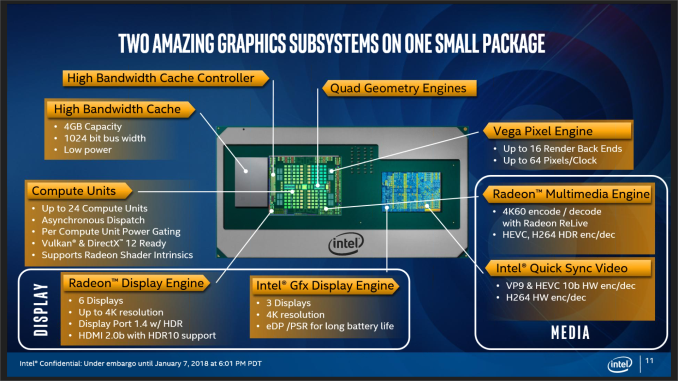Intel Core with Radeon RX Vega M Graphics Launched: HP, Dell, and Intel NUC
by Ian Cutress on January 7, 2018 9:02 PM ESTSo Why Two Sets of Graphics?
To answer this question, there can be a few possible answers.
The cynical approach is to say that Intel is rehashing a H-series design for the CPU portion, so rather than spending money to make masks that cuts it off, Intel is being cheap for what would be a low volume product.
A technical reason, which readers may or may not agree with, is to do with functionality and power. Despite these chips being 65W and 100W, we are going to see them being used in 15-inch and 17-inch high-end devices, where design is a lifestyle choice but also battery life is a factor to consider. For doing relatively simple tasks, such as video decoding or using eDP, firing up a big bulky graphics core with HBM2 is going to drain the batteries a lot faster. By remaining on the Intel HD graphics, users can still have access to those low power situations while the Radeon graphics and HBM2 are switched off. There is also the case for Intel’s QuickSync, which can be used in preference of AMD encoders in a power-restricted scenario.
The Radeon graphics in this case offers power-gating at the compute-unit level, allowing the system to adjust power as needed or is available. It provides an additional six displays up to 4K with the Intel HD graphics that has three, giving a total of nine outputs. The Radeon Graphics supports DisplayPort 1.4 with HDR and HDMI 2.0b with HDR10 support, along with FreeSync/FreeSync2. As a result, when the graphics output changes from Intel HD Graphics to Radeon graphics, users will have access to FreeSync, as well as enough displays to shake a stick at (if the device has all the outputs).
Users that want these new Intel with Radeon Graphics chips in desktop-class systems, might not find much use for the Intel HD graphics. But, for anything mobile or power related, and, especially for anything multimedia related, it makes sense to take advantage of the Intel iGPU.











66 Comments
View All Comments
skavi - Monday, January 8, 2018 - link
Do we even have 8th gen Y?evilpaul666 - Sunday, January 7, 2018 - link
So is this all Intel has for CES?extide - Sunday, January 7, 2018 - link
So, here we have a MCM with chips from three different fabs on it. 1 from Intel, 1 from GF, and one from Samsung or SKHynix.Have we ever seen something like that before?
Penti - Sunday, January 7, 2018 - link
So will we see a 24 CU Vega-chip with HBM2 as a discrete chip for laptops too? It's essentially designed as a lower tier RTG/AMD GPU, kinda specced like a replacement for Polaris 11.Cooe - Monday, January 8, 2018 - link
AMD announced Vega Mobile today which is pretty much exactly that. It's a freaking tiny package,and for that reason I expect it to be pretty successful vs Nvidia's traditional GDDR5 designs. (Though no word yet if the Vega Mobile and the semi-custom chip here are the same as far as CU count and what not, but it wouldn't be surprising).
Penti - Monday, January 8, 2018 - link
Same Z-height as KBL-G at least. Vega mobile was expected, is definitively related to the chip on the KBL-G package but might be a chip with a slightly different CU/SP count but renders make it look exactly the same.flashbacck - Sunday, January 7, 2018 - link
"Intel’s internal graphics, known as ‘Gen’ graphics externally, has been third best behind NVIDIA and AMD for grunt."Grunt? huh?
Holliday75 - Monday, January 8, 2018 - link
I thought the same thing.Kevin G - Sunday, January 7, 2018 - link
The one thing missing from this article, which I think if fair in the context of the fury of news last week, are Spectre and Meltdown. Intel is currently facing multiple law suits about it, especially in the context of bringing to market with a security flaw. These security flaws maybe the death blow to Cannon Lake which was originally to be a late 2018 part and already had the desktop parts removed form the line up in favor of Coffee Lake.There is another Lake part coming in late 2018 called Whiskey Lake and the rumors are pointing toward it being yet another Sky Lake based 14 nm part (see Kaby and Coffee Lake). I have no idea what these parts could provide other than potential fixes for Meltdown and Spectre minus the offhand possibility of an updated GPU. Next actual CPU core design is set to be Ice Lake which may also be their first 10 nm chip. Intel has shied away from doing to many firsts as once due to the difficulty of isolating problem (is it process? design? packaging? interconnect?) but Intel may have no choice.
Intel's CEO is set to take the stage at CES tomorrow so we'll probably get some answers to their roadmap as well has some groveling about Meltdown and Spectre.
Oh, for the curious, you can look up what codenames Intel does have the horizon here and see Whiskey Lake for yourselves:
https://www.intel.com/content/www/us/en/design/pro...
UtilityMax - Thursday, January 11, 2018 - link
This gotta be the worst time to announce a new Intel CPU. Sadly, I think the sheep that are the average consumers will gladly buy PCs with these CPUs.